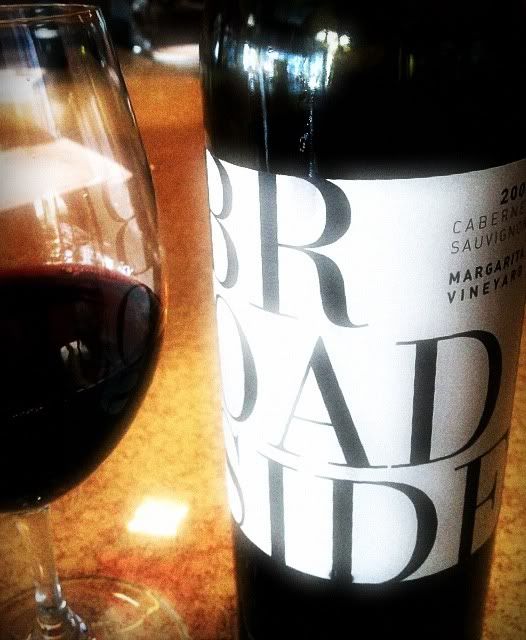
One of my favorite stops for "anytime wine tasting" in Southern California is the Santa Monica wine bar Pourtal. Stephen Abronson's cozy little space near the beach is filled with Enomatic taps where wine is dispensed by the ounce. You can have a taste of many or a glass of one or two. There are always themed Tasting Tours which rotate on a monthly basis. Pourtal's Wine Director Rachel Bryan makes excellent choices on the wines featured at any given time.
I was drawn to try the Broadside Cabernet Sauvignon when I noticed its grapes were taken from the Margarita Vineyard in the southern part of the Paso Robles AVA. I recently toured this vineyard - the Ancient Peaks estate vineyard - and was mightily impressed with the wines which Ancient Peaks crafted from that fruit. My hopes were high for the Broadside effort.
Broadside winemakers Chris Brockway and Brian Terrizzi attempt to let the grapes do the talking. The wine is made naturally, without yeast, bacteria or acid. Aging occurs in 100% French oak - 2% new - and the varietal makeup is 97% Cabernet Sauvignon and 3% Petite Verdot, also from Margarita Vineyard. It has an alcohol level of 14.1% abv. The Broadside Cab retails for $20 per bottle.
As expected, the wine looks dark and inky in the glass. The nose is a little hot at first, but that settles down quickly. Big aromas of dark fruit are laced with the minerals Margarita Vineyard is known for. On my tour of the vineyard, I saw firsthand the ancient oyster shells peeking up from the earth - a reminder of the land's former state as a seabed.
The taste is also enticingly dark and full of those wonderful minerals. Cassis and black cherry join with a vanilla spice component. There's a lot of wine here for $20.
Follow Randy Fuller on Twitter.
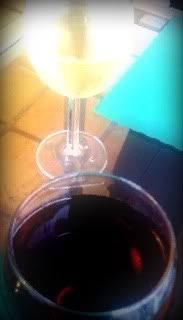
The wines on the list at Salades de Provence, my favorite French bistro in Los Angeles, are not fancy, but they always seem to pair to perfection with the wonderful food they make. I tried one recently which fit well with the food, but was a bit lackluster on its own.
The Sainte Chanelle Vin de Pays D’Oc Pinot Noir is the wine in question. It was smooth as silk, but dull as dishwater.
The Vin de Pays designation translates as “country wine,” and is a French wine production level below that of the A.O.C. and above the Vins de Table classification. Vins de Pays D’Oc hail from the Languedoc-Roussillon area in the south of France, near the Mediterranean.
The jury is mixed on this wine’s nose. Denise smells raisins and beef, while I find the nose quite challenged, with just a hint of roses. The taste is nice enough, if a bit plain. Earthy cherry dominates the palate and it pairs well with mushrooms and smoked salmon. I do not find its unobtrusive quality to be a virtue, though.
The Sainte Chanelle cost $9 per glass, and I’ve seen the ‘07 vintage for $9 a bottle at a local wine store, but I’ll take a pass on it the next time I see it offered.
The trip wasn't a total loss where wine was concerned, though. Denise enjoyed her Bordeaux Blanc quite a bit. I've written about it before.
Follow Randy Fuller on Twitter.
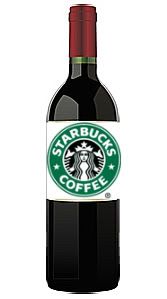
You may have heard that the national coffee chain, Starbucks, is experimenting with the addition of wine and beer to some of its locations. What does a Starbucks wine list look like? According to the Washington Wine Report, it looks about like what you'd expect from a broad-based national chain.
There were plenty of people wondering out loud whether Starbucks would roll out wine lists featuring local or regional wines. In a way, they have. But don't get too excited.
As I understand it, Seattle was the test market. I've seen notice of a Portland Starbucks, too, offering wine and beer.
There are seven wines on the lists I saw from both cities, four reds and 3 whites. The Pacific Northwest is represented by only three wines, and all come from beneath the Chateau Ste. Michelle umbrella.
Erath Pinot Noir, 14 Hands Hot To Trot red blend and Chateau Ste. Michelle's own Riesling qualify as regional wines, but they are from a very large producer and the selections are widely available.
Other choices on the menu include the Alamos Malbec from Argentina, the Canili Pinot Gris from Italy, the Martini California Cabernet and William Hill's Napa Valley Chardonnay. Decent wines, all, but nothing to make anyone jump and run down to Starbucks to get some before they run out.
I agree with the Washington Wine Report that the Starbucks wine list has a very corporate feel, not at all reflective of regional wines. Of course, I would have expected about as much. The company - if they follow through on rolling out the barrels nationwide - will watch the bottom line by purchasing safe wine choices in quantities great enough to afford volume discounts.
It's too bad, though. When Starbucks introduced their line of coffee drinks, they were giving us something we weren't getting anywhere else. With their wine list, it appears they are satisfied to give us something we can get everywhere else.
Follow Randy Fuller on Twitter.
The wine industry in Colorado began in 1890, when then-governor George Crawford planted 60 acres of grapes and other fruit along Rapid Creek, near Palisade. There was modest growth in grape growing and winemaking until you-know-what. Prohibition killed many states' wine industries. In Colorado, the bell tolled early, as the state passed its own Prohibition statute in 1916 - predating the national law by four years. All the grapevines were pulled up at that time in favor of fruit orchards. It wasn't until the late 1960s that grapes and wineries began reappearing in the state.
Norman Christianson was a geologist who made a career of mineral exploration before becoming a vintner. He founded Canyon Wind Cellars in 1991. A family-owned estate winery, Canyon Wind employs Napa winemaker Robert Pepi, who oversees the winemaking work of Jay Christianson.
Canyon Wind Cellars is located in the Grand Valley AVA, in Palisade, Colorado east of Grand Junction north of the Colorado River. The high altitude location offers their grapes hot days and cool nights in which to ripen in the sandstone soil.
The Christiansons are proud of their winery's greenness. In the vineyard, sustainable practices are observed: no herbicides are used and only organic pesticides when needed. A gravity flow system gets the wine to the barrel cellar using no electricity.
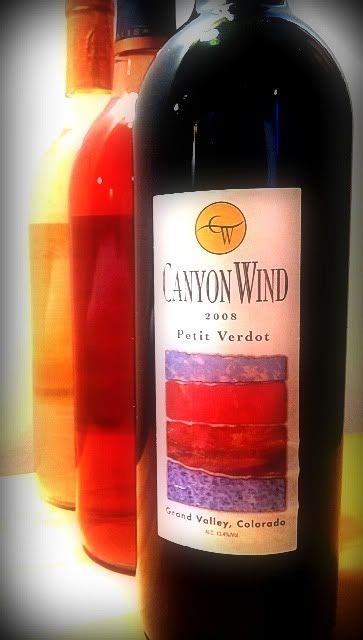 Canyon Wind Wines
Canyon Wind Wines
I received three wines to sample. Two of them are from Canyon Wind's 47-Ten series - a Pinot Grigio/Chardonnay blend and a Merlot rosé - and a Petit Verdot from their varietal line.
47-Ten White 2010
The name of the 47-Ten series refers to the altitude of the vineyards, 4,710 feet. That’s Rocky Mountain high. 60% of the wine is Pinot Grigio from the Cliffside Vineyard while the remaining 40% is Chardonnay from the Riverside Vineyard. At 13.6% abv, this wine does not bring the heat.
The nose shows lovely floral notes and honeydew on a somewhat earthy background. There are melons and peaches on the palate with a shading of yeasty minerality. It’s really quite a delicious white, with a zesty acidity. There’s plenty here to make it useful at the lunch or dinner table.
The mouthfeel is nice and full, and the nose and palate both show a bit of spiciness and vanilla. I was surprised to learn this is an unoaked effort - but the Pinot Grigio was aged sur lie in stainless steel for six months before being blended with the au natural Chardonnay. This explains the rich feel of this wine. (When the dead yeast cells - lees - fall to the bottom of the vat after fermentation, the wine is left in contact with the lees for a time to impart a richness and yeasty flavor.)
Put a chill on the 47-Ten White, and you have a perfect companion on the deck this summer.
47-Ten Rosé 2010
Another from Canyon Wind's 47-Ten line, this rosé is such a deep pink it’s almost red. Made from 100% Merlot, taken completely from Canyon Wind’s Riverside Vineyard, this wine is produced entirely in stainless steel.
The nose comes on like a fruit truck overturned. Fresh, ripe strawberries and cherries abound on the nose and palate, and it’s all fruit - no candy. It’s a wonderfully dry rosé with a nearly astounding level of acidity. I wouldn’t pair it with steak, not because I don’t think it could stand up it, but because I like a red wine with beef. I wouldn’t think twice about having this wine with a grilled pork chop. At 12.3% abv, it doesn’t hit so hard that you have to worry about the second glass.
Petit Verdot 2008
This blend of Petit Verdot and a two-percent splash of Cabernet Sauvignon is sourced entirely from Canyon Wind’s Riverside Vineyard. In the original planting for the vineyard in 1991, it was thought two blocks of Merlot from different nurseries were put in the ground. It turned out that one block was not Merlot, and it wasn’t until eleven years later - with the help of genetic fingerprinting - that the mystery block was determined to be Petit Verdot. A low-intervention vinification leads to 22 months in French and American oak.
Petit Verdot usually plays a supporting role in wines. Indeed, even this grape - during its time in the Twilight Zone - was used for blending. In this wine Petit Verdot gets to sit in the driver's seat and Cabernet Sauvignon has to ride shotgun.
The wine’s color is deep, dark red, but light does get through. On the nose, immediately upon pouring, there is a strong whiff of alcohol. That does not remain for long. In fact, the wine settles down very nicely in short order. The alcohol content is only 13.4% abv, so it was a bit of a surprise to find it so forceful at first. Other elements vie for my attention in much the same way. One whiff is full of amazing fruit - cassis and blueberry, jammy as can be - while another has campfire smoke and creosote on it. It’s like a fireworks show for the nose.
There’s a lovely greenness in the flavor profile and it’s unmistakable even amid all the intense fruit flavors. The wine has a medium-full mouthfeel and a firm tannic structure. It does not lack acidity and shows plenty of the earth in which the grapes were grown. Behind it all is a freshness that makes me think of a mountain stream - an unusual quality in a red wine, at least in my experience.
Our thanks go to Canyon Wind Cellars for contributing these wines and becoming an able representative for Wine Country Colorado.
Follow Randy Fuller on Twitter

Wine Goes To The Movies
with NowAndZin.com and TrailersFromHell.com
"Notorious," the 1946 classic from master of suspense Alfred Hitchcock, actually features a wine as a character in the movie. Hitch put a big clue to his mystery in a bottle of wine from Pommard, in France's Burgundy region.
Hitchcock was a wine connoisseur and really loved the northern California wine country. He loved it so much, he bought a ranch and vineyard near Scotts Valley during the filming of 1940's "Foreign Correspondent." That's why you see so many northern California locations in Hitchcock films - so he could be close to his digs between Santa Cruz and San Jose.
In "Notorious," when Cary Grant drops that bottle of 1934 Volnay Caillerets Bouchard, my heart skips a beat every time I see it. "Not the premier cru!" Fortunately, there's no great wine in the bottle, just a little pesky uranium ore which he neatly sweeps under the wine rack. That's where radioactive isotopes are always swept so they'll go unnoticed until someone brings in a Geiger counter.
No hazmat suits, not so much as a rubber glove for protection. Uranium is only weakly radioactive, which explains why Cary Grant didn't suffer any sort of disfigurement. If anything, he became even more suave and debonair afterward.
Ingrid Bergman doesn't fare so well in the movie. Oddly, she gets hers from a cup of coffee. Someone must have slipped some uranium into the sugar bowl.
You can find a recent vintage of Bouchard Volnay Caillerets for $50 to $60, but it appears that for the 1934 vintage you'll have to go to auction, so expect to spend a lot more. Louis Jadot has a Pommard which sells for around $40, and that appears to be the low end of the price range for that appellation.
If you need a really cheap date night, see the Blood Of The Vines pairing for "Arsenic & Old Lace."
Bargain Burgundy:
2008 Domaine Ballot-Millot & Fils Bourgogne Rouge - Leave the auction to Cary Grant. Here's some Pommard (with a little Meursault and Beaune thrown in) for about $20.
2007 Laboure Roi Bourgogne Blanc "Maximum" - A white blend of Meursault and Mâcon grapes - not far from Pommard - this Chardonnay is under $20.
Caves Bailly Lapierre Cremant de Bourgogne Brut - A sparkler from near Chablis, this will give you that Cary Grant feeling for about $15.
Blood Of The Vines also appears on the cool Trailers From Hell blog, From Hell It Came.
Follow Randy Fuller on Twitter.
Follow Trailers From Hell on Twitter.
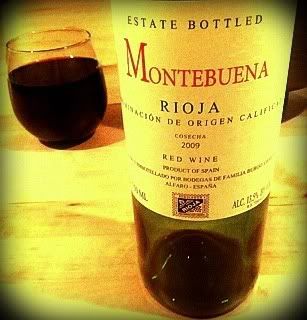
Wines from Spain get a lot of press lately for being great values. Reasonable price points and generally high quality have many wine lovers looking to regions like Rioja, Toro, Calatayud and Rias Baixas for great buys. I recently attended a tasting event in which a couple dozen tables full of Rioja wine were poured. All of them were of high quality, even the ones retailing for $10 or less. I had high hopes for the Montebuena Rioja wine which retailed for all of $12. I picked it up for eight bucks at a Los Angeles wine store sale.
Montebuena is produced by Bodegas Burgo Viejo of Alfaro, in the Rioja's Ebro Valley. It's a 100% Tempranillo wine with a 13.5% abv number.
Upon opening and pouring, I'm a little disappointed there there's a good deal of alcohol on the nose and palate. Even on the second - and third - night the bottle is open the alcohol is the dominant aroma.
Bright cherries come across rather uncomplicated otherwise, with just a hint of spice, but the bite is sharp - too sharp for my enjoyment. The fruit is bright, but with so few supporting elements the palate is on the thin side. There’s also an astringency to it that helps tip the scales on the side of unpleasantness.
Even as the tannic nature of the wine lessens a bit - after three days - the flavors don’t deepen or get richer, they simply go flat. Unfortunately, the astringency is still there. It's not such a shock that an inexpensive wine fails to impress, but it is a disappointment that such a great wine region is so poorly represented.
My guess is that pairing the Montebuena with the biggest, juiciest, fattest piece of beef you can find would improve its lot - at least the tannins would have something on which they could work. I sipped it solo, and I have enjoyed Two-Buck Chuck more - a lot more.
Follow Randy Fuller on Twitter.
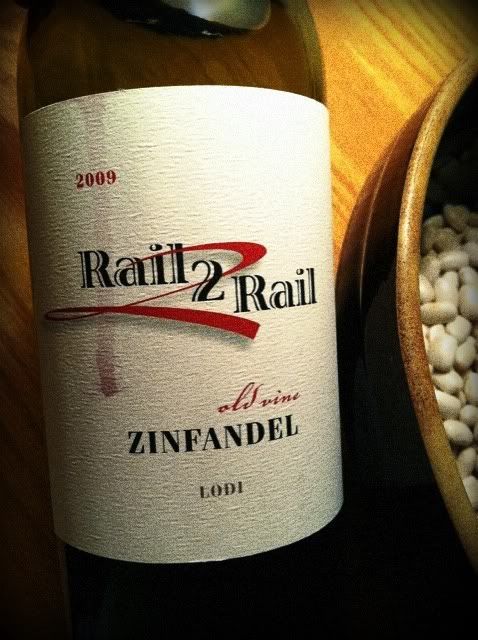
Buying a $10 wine can be a real gamble. There are plenty of good ones on the shelf, but there are some dogs, too. Zinfandels that thrill generally run a bit higher than a ten-spot, so my expectations were slim, hanging by the notion that an old vine Lodi Zin would save the day at that price point.
Rail2Rail Zinfandel is produced by the Laumann Family Estate Wines of Santa Cruz. This is one of three labels produced by Eric Laumann, the other two being Cambiata and Ludwig.
I have tried Cambiata's Albarino before, and liked it. I also like the fact that Laumann trades in grapes you don't see very often in California, like Tannat and Dornfelder. The '08 vintage of the Zin won awards at a couple of competitions, so I was looking forward to this Zinfandel.
The name, by the way, is taken from a surfing term which describes a "full commitment S-turn." A rail-to-rail turn is a showy move that sprays water everywhere. Along that line, the label promises a big wine, but one which keeps the tannins in check and balanced.
The wine does come on big, with a 14.5% abv number. Most of that shows up on the nose when the bottle is first opened. The smell of alcohol nearly knocked me over on the first whiff. Big , bright cherry and blueberry aromas do manage to make their way through.
Even on the third night the bottle was open it was alcohol-heavy. It also took on more of a candy-like appearance on the palate which I didn’t find too enjoyable. A brambly character that appeared saved it from despair, but just by a bit. It's a far cry from unpalatable, but I kept wishing more had been delivered.
Rail2Rail is a $10 Zinfandel that, unfortunately, drinks like one.
Follow Randy Fuller on Twitter.

Do you worry about whether or not the wine you drink measures up to European standards? Wine Spectator contributing editor Matt Kramer wondered that recently as he was sitting in a bar in Salzburg sipping a Zweigelt. Aah, the life of a wine writer.
Kramer, in a Wine Spectator article, points out that in the past three decades great advancements have been made in winemaking the world over. European wines were once thought unmistakably superior in quality to wines from Australia, New Zealand, Argentina, Chile and, yes, America.
In the article, Kramer goes on to suggest a scheme for judging New World wines against European ones. Variety, originality, technical prowess, finesse and vocabulary are the criteria he came up with for measuring wines from different regions head to head.
It's not a bad idea - sports fans have always relied on a list of criteria to rate a team from one era against one from another. Such comparisons help pass the time while drinking at the bar, but they rarely produce definitive results.
Why should it matter? What is to be gained by trying to pick a winner between the 1927 Yankees and the 1976 Reds, except the burnishment of fan pride? Actors often complain about the competition they are thrust into by the Academy Awards. Why should there have to be a winner if the nominees all did a great job of acting?
Are European wines better than California wines? The ultimate test is your own palate. There's plenty of room in the big ol' world for great wine from everywhere. Others have said it before me, but it bears repeating: drink what you like. Your favorite wine is the best wine in the world, and nobody can argue that away from you.
Follow Randy Fuller on Twitter.
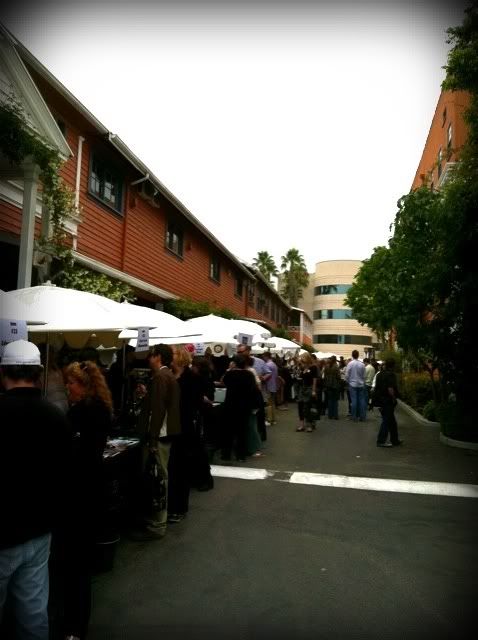
Los Angeles wine tasting events held on movie studio backlots are a common enough occurrence that they don't generate much "gee wow" response from attendees. The tasters at the 2011 LA Wine Fest seemed casual about their surroundings - Raleigh Studios in Hollywood - but they did seem to be enjoying the wines they were tasting.
Many wine events I attend are designed for the wine trade and/or media, but I love going to events populated by everyday wine lovers. I enjoy talking to people who don't do a lot of wine tasting as they get a chance to sample grape varieties they aren't familiar with and explore wine producers they may not encounter where they do their wine shopping.
There are always the "party-goers" who navigate from table to table, slugging back every sample poured for them like it's a jello shot. I always hope these people have a designated driver in their entourage. Spit buckets were provided at nearly every stop, but they went largely unused at this event. There was one young lady who - either recognizing she would have to limit her intake or displeased with the sample in hand - poured the remainder of her taste into a nearby bush.
 The tables offering wine were typically crowded, as were the sites where a morsel of food could be sampled. I stopped and chatted with a fellow named Mark, who manned the Icelandic Glacial Water booth. I told him I'd run his photo as "The Loneliest Guy At The Wine Event," but he did manage to give away a fair amount of his bottled water, singing the praises of it all the while.
The tables offering wine were typically crowded, as were the sites where a morsel of food could be sampled. I stopped and chatted with a fellow named Mark, who manned the Icelandic Glacial Water booth. I told him I'd run his photo as "The Loneliest Guy At The Wine Event," but he did manage to give away a fair amount of his bottled water, singing the praises of it all the while.
Match Vineyards is a small, family-owned winery which makesCabernet Sauvignon from their pair of Napa Valley hillside vineyards. I tried their '07 Butterdragon Hill Cab upon entering the festival, and it held up as one of my favorites of the day. It shows very rich currant and graphite aromas with great tannic structure and a finish highlighted by coffee and licorice. Their Baconbrook Cab shows a lighter version of the profile. Winemaker Cary Gott - Joel Gott's son - carries his four-generation winemaking lineage in style.
Witch Creek Winery of Carlsbad, California in San Diego County poured the product of winemaker Ryan Baker. The winery is two blocks from the ocean in that quaint seaside community. The wines I tried were sourced in El Dorado County, Clarksburg and Mexico! Having limited experience with wines made from Mexican grapes, I jumped right in with theirSangiovese from the Valle de Guadalupe in Baja. The smokey cherry nose and flavors of a wood fire captivate. They also make a Nebbiolo grown in the same locale. The El Dorado County Reserve Cabernet Franc smells of beautiful cassis and cherry and has a vegetal layer draped over the lush fruit. A Viognier sourced from Clarksburg's Heringer Vineyards shows a lovely floral nose and a nice acidity which lasts into the finish.
 Rob Barnett, CEO and founder of Vin Village was there, pouring wines by Ricardus Corculum. That's the nom de vinof Richard Hart. The Latin subtext continues on the labels for his Napa Valley Cabernet Sauvignon, dubbed "Four A's." An A was an old Roman coin, and a wine which cost four of them was considered very good. The Ricardus Corculum Four A's Stagecoach Cabernet Sauvignon is luscious and elegant in both the '07 and '08 vintages, the tannins a little bolder in the younger one. The Ricardus Corculum ClandestZin Dry Creek Valley Zinfandel 2007 has a deep nose showing smokey chocolate and a very long finish.
Rob Barnett, CEO and founder of Vin Village was there, pouring wines by Ricardus Corculum. That's the nom de vinof Richard Hart. The Latin subtext continues on the labels for his Napa Valley Cabernet Sauvignon, dubbed "Four A's." An A was an old Roman coin, and a wine which cost four of them was considered very good. The Ricardus Corculum Four A's Stagecoach Cabernet Sauvignon is luscious and elegant in both the '07 and '08 vintages, the tannins a little bolder in the younger one. The Ricardus Corculum ClandestZin Dry Creek Valley Zinfandel 2007 has a deep nose showing smokey chocolate and a very long finish.
Randy Miller, President and "Wine Pouring Specialist" forSilver Stone Winery offered one of his own and one from another. His Silver Stone 2006 Pinot Noir is made from Santa Rita Hills fruit and clocks in with a very modest 13.5% abv number. A beautiful fruit punch nose leads to lovely cherry and raspberry flavors which flow into a long finish. Miller also poured a Petite Sirah from S. Morris Wines. The "S" stands for Sean, and he's getting recognition for his small-production boutique wines. His 2007 Roadrunner Ranch Paso Robles Petite Sirah is brawny at 15.1% abv, but the alcohol does not prove a hindrance.
The Santa Rita Hills Winegrowers Alliance brought several nice bottles along. Fiddlehead Cellars'08 Sauvignon Blanc shows very elegant and subdued aromas and flavors with great acidity. Zotovich Family Vineyards' 2009 Estate Chardonnay is done in neutral oak. It's juicy and not too acidic. Weber Wine offered the '09 Babcock Vineyard Mishelle Pinot Noir - lovely cherry aromas and a refreshing tartness on the palate.
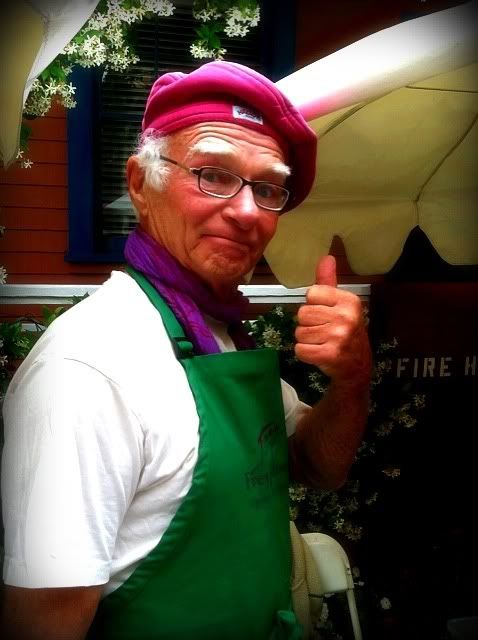 Mendocino County's Frey Vineyards brought Uncle Mickey along for the event. That's his picture, and he is every bit the bon vivant he appears to be. He's proud of his family's organic, no-sulfites-added approach to winemaking. Their '09 Sangiovese shows a lot of smokey fruit, a nice pepper angle highlights the '09Zinfandel and the '09 Frey Syrah is old-world delicious, one of the best Syrahs I've had.
Mendocino County's Frey Vineyards brought Uncle Mickey along for the event. That's his picture, and he is every bit the bon vivant he appears to be. He's proud of his family's organic, no-sulfites-added approach to winemaking. Their '09 Sangiovese shows a lot of smokey fruit, a nice pepper angle highlights the '09Zinfandel and the '09 Frey Syrah is old-world delicious, one of the best Syrahs I've had.
Who knew downtown L.A.'s San Antonio Winery makes wine in Italy? I didn't, but I was put on alert with their Il Conte d'Alba line from Piedmont. The Stella Rosa Imperiale Moscato and Stella Rosa Imperiale Brachetto d'Acqui DOCG are both fully fizzy, sweet and quite delicious. While I was at the table, several attendees tasted and were as wowed as I was. Their San Simeon Paso Robles Merlot is spicy and smokey, while their Maddalena Monterey Pinot Grigio lays a big mineral base for the fruit and flowers to come.
Jada Vineyard and Winery, from Paso Robles' west side, poured a variety of wines, but the one that knocked me out was the 2010 "1149" Rosé. Blended from Cabernet Sauvignon, Merlot,Grenache and Syrah, this bone-dry pinkie shows beautiful strawberry and cherry with a long, pretty finish.
Firestone Walker Brewery offered a changeup for those whose palates had tired of wine - or who just wanted a beer. Their California Pale Ale is light in color and shows a gigantic lemon rind flavor, while the Double Barrel Ale is dark, malty and delicious.
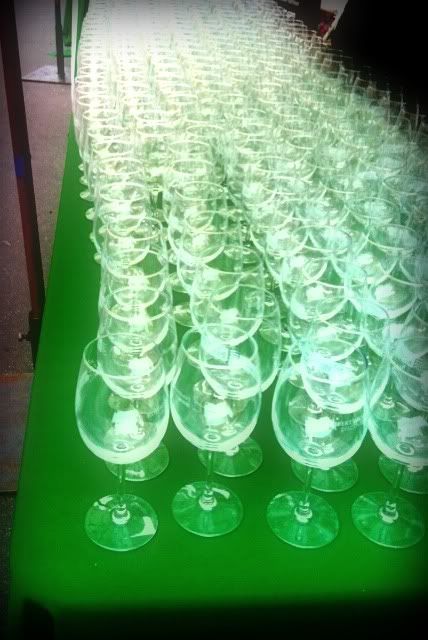 Bixler Vineyards is a family farm/winery in California's San Joaquin Valley. They've been farming there for 150 years, although grapes are relatively new to them - their vines are 25 years old. Their White Blend is made from Viognier, Chardonnay and Sauvignon Blanc. It shows freshness with minerals and green apples. The Bixler Red Blend is Merlot, Syrah and Petite Sirah and features tart cherry and raspberry flavors.
Bixler Vineyards is a family farm/winery in California's San Joaquin Valley. They've been farming there for 150 years, although grapes are relatively new to them - their vines are 25 years old. Their White Blend is made from Viognier, Chardonnay and Sauvignon Blanc. It shows freshness with minerals and green apples. The Bixler Red Blend is Merlot, Syrah and Petite Sirah and features tart cherry and raspberry flavors.
The Temecula Valley Winegrowers Association brought a variety of Temecula Valley product with them. As much as I admire some of the winemaking in Temecula, I wasn't too impressed with the samples from Stuart Cellars and Falkner Winery. The Cougar Vermentinosimply wasn't very good. The Wiens Family Cellars stainless steel blend of Roussanne and Chardonnay is nice. It offers a very smokey nose with minerals on the palate and a great acidity.
Lodi's Michael David Winery had their 7 Deadly Zins to try. It's a favorite of mine anyway, and I found it paired quite well with a piece of Red Velvet Chocolate from the Bread Basket Cake Company table.
Wedell Cellars poured a Syrah with a nice, funky nose but a rather unbalanced taste. TheirChardonnay is positively golden in color with a wooden nose and a nutty palate.
Cielo Farms of Malibu showed a number of wines. I concentrated on their Woodstock Collection. The Red House Bordeaux blend shows a great sour cherry flavor; the '09 Purple Haze has a blueberry nose and luscious fruit on the palate; Blackbird is Malbec and Petit Verdot, with deep and rich dark fruit and a hint of chocolate on the finish.
Follow Randy Fuller on Twitter.

Wine Goes To The Movies
with NowAndZin.com & TrailersFromHell.com
In a former life, I was a radio disk jockey. Clint Eastwood's "Play Misty For Me" held a special fascination. I figured if I was good enough at it, I would someday have a cool house near the ocean, drive a sports car on PCH and do my show on tape so I could come and go as I pleased. The downside: women with knives.
I was a DJ for quite a long time. It seemed like a long time, anyway. I never got the ocean-view property or the sports car on PCH and I spent many long hours chained to a microphone. On the other hand, I never got stabbed.
As far as wine goes for Clint Eastwood, he likes it. There's a rule which clearly states if you like jazz, you must like wine, and he certainly likes jazz. It's a package deal. He plays a jazz DJ in “Play Misty For Me," so even his character must like wine, too.
There are plenty of references to the notion that Clint is like a fine wine - getting better with age. He doesn't want people to celebrate his birthday anymore, so he asks his wife not to get him anything special, just have a glass of wine with him.
In his movie "Hereafter" Eastwood chose Rivetto's Barbaresca to be displayed in one scene, but finding a specific wine on which to hang Eastwood's hat isn't easy.
Clint Eastwood does have a beer connection: Pale Rider Ale bore his name back in the '90s, a tip of the black Stetson to his movie of that name. Eastwood actually wanted the ale to be called "The Beer With No Name," as an homage to the character he played in his spaghetti western trilogy. Someone probably figured a beer with a name would be easier to sell than one without, but I recall that Prince did alright without a name for a while.
The man who wrote the book, "Play Misty For Me," was Paul Gillette, something of a wine expert himself while he was alive. He published some wine industry trade newsletters, but that thread appears to go no further.
The film is set in Carmel, so perhaps a wine from Monterey County would be appropriate. There’s a proprietary brand house wine at Clint’s Carmel restaurant, Mission Ranch. There’s also one at the restaurant he used to own, the Hog’s Breath Inn. Carmel Valley winery Chateau Julien is just down the road and was host to the First Lady’s Reception in 2008, an event Mr. and Mrs. Eastwood attended, so let’s go there.
Chateau Julien’s flagship wine - Merlot - was their very first release in 1982. Here’s how they describe it: “Hints of cedar and vanilla nuances accent aromas of lush berry and robust dark cherry. Its subtle oak edge and moderate tannins complement this full-bodied wine’s fine acidity and ripe, intense fruit. A nice complexity and texture through a smooth, lingering finish. Will age nicely for up to ten years.”
“Play Misty For Me” has been aging for over 40 years, and Clint for much longer. If you ask me, they both keep getting better.
P.S.: The answer to the anagram in last week's Blood Of The Vines "Rosemary's Baby" article: Velvet Devil Merlot
Follow Randy Fuller on Twitter.

Everyone's always looking for a bargain, and wine drinkers are no exception - well, maybe the guy who paid $124,000 for a bottle of Burgundy is. My guess is he doesn't rummage in the bargain bins.
Wine writer and $10 wine proponent Jeff Siegel - known in the blog world as The Wine Curmudgeon - passed along a tip on a book due out in the fall of 2011 which promises to give bargain hunters the low down on the low-priced brands
Siegel has an interest in the book - he's in it - but it sounds like a tome that would be of interest to wine lovers who live on a budget.
The book is called "A Toast To Bargain Wines: How Innovators, Iconoclasts and Winemaking Revolutionaries Are Changing the Way the World Drinks," and it's due out in November.
The author - George Taber - wrote the book on The Judgment Of Paris, the famous blind tasting in which wines from California beat out French wines for the first time. In his new book, he will detail how some wine producers are looking to lower-priced wines as a part of their marketing strategy. Plenty of budget wine recommendations will also be offered in the book.

Recently, my wife had a hair appointment in Beverly Hills, followed immediately by a girlfriend lunch, also in Beverly Hills. I dropped her off and ran a few errands, but still had a lot of time to kill in Beverly Hills. I turned to the wine.
I had been meaning to explore few wine-oriented places in the Hills of Beverly for quite some time, and this sunny Saturday afternoon seemed perfectly suited to the occasion.
It was around noon - okay, it was 11:32 - when I walked into Enoteca Drago on Cañon Drive. There are, maybe, a dozen Italian restaurants in Beverly Hills. About 11 of them are owned and operated by the Drago family. That’s alright by me, as I always have wonderful food and a thoughtful wine list at a Drago restaurant.
Enoteca is even more focused on wine than the other family locations, since it is a wine bar. The menu offers 11 different flights of wine in the $15 - $20 range, while single glasses are in the $9 - $23 neighborhood. The wine list has lots of variety, including late harvest selections, Ports and Grappa choices, too. There’s also a complete menu of Italian fare to pair with the wines.
I chose a flight of three medium-bodied, semi-aromatic white wines for $17. Included in the flight were the following wines, with my tasting notes:
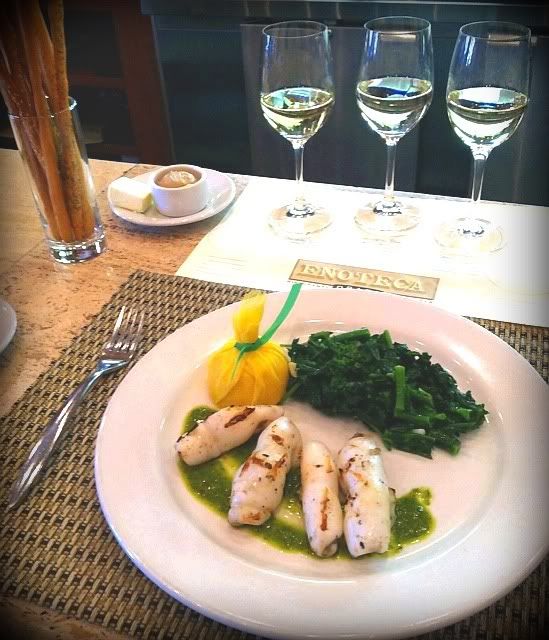 Greco di Tufo, Terradora DiPaolo, Campania 2010 -
Greco di Tufo, Terradora DiPaolo, Campania 2010 -
Richest color of the trio. Apricot and ocean on the nose, golden apples with a hint of honey on the palate. Minerals abound, great finish. Greco is an Italian grape, thought to be of Greek origin.
Sauvignon Blanc, Joel Gott, Napa Valley 2010
Palest of the three, almost clear. Grassy and fruity notes make up the nose, with melon and herbal notes present. Peach and apple cobbler flavors are on the palate. The cobbler is a complete surprise, but it works.
Gavi, Villa Sparina, Piemonte 2010
Medium straw in color the light nose is very hard to pick up. What is that lovely taste? It seems like cantaloupe or honeydew. There’s a lot of minerality, too. Wine from Gavi area of Piemonte is made exclusively of the Cortese grape.
I ordered the calamari alla griglia with this flight. All three wines pair well with the calamari, the Gavi matches it the best. The Joel Gott Sauvignon Blanc went best with the rapini. By the way, when grilled calamari is offered, it should always have the grill marks on it. It does at Enoteca Drago.
After checking in with the wife and friend at Cafe Roma (oddly enough, not a Drago restaurant) I was invited to go away a while longer, as the chatting got out of hand.
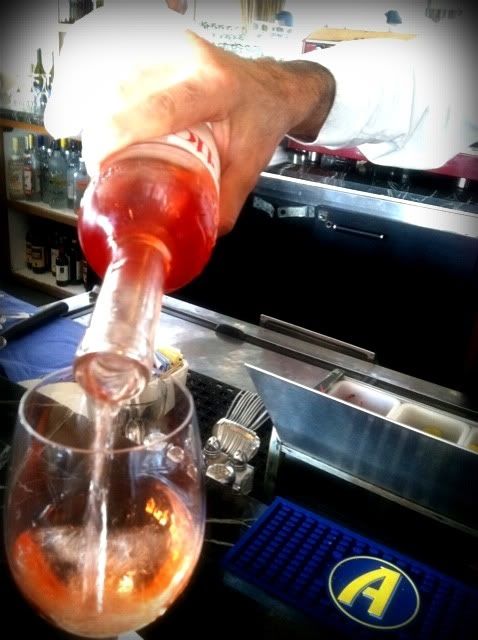 Just up the street is Il Pastaio. Yes, it’s another Drago restaurant. This place looked really busy and festive at 1:00 or so Saturday. As I approached, a guy in a big, white Cadillac pulled up, with Italian music blaring at festival volume from his car stereo. As he made the corner, with the window down, he looked over at the sidewalk lunchers and led with his finger to the music.
Just up the street is Il Pastaio. Yes, it’s another Drago restaurant. This place looked really busy and festive at 1:00 or so Saturday. As I approached, a guy in a big, white Cadillac pulled up, with Italian music blaring at festival volume from his car stereo. As he made the corner, with the window down, he looked over at the sidewalk lunchers and led with his finger to the music.
The mobile maestro was obviously enjoying the moment to share his passion, and I overheard a guest comment, “Wow, that’s real.” Indeed. I stepped inside and took a seat at the bar.
I only examined the wine list for rosé, as that’s what I really wanted. The Chiaretto Provenza is $10.50 by the glass.
Made with Groppello, Marzemino, Sangiovese and Barbera grapes, the wine hails from the area near Lake Garda in the northern part of Italy. The winery, Azienda Agricola Provenza, is located in the Lombardy region. Lake Garda has a special microclimate in which palm, olive and lemon trees thrive practically at the foot of the Alps.
The wine is a nice, rich, salmon color and the ice cold status at which it’s served makes it a little hard to discern too much on the nose. The palate shows bright cherry and strawberry fruit with a hint of raspberry tartness. The wine is dry and crisp - very refreshing. The finish is good, and minerals are the last thing remembered after the sip is gone.
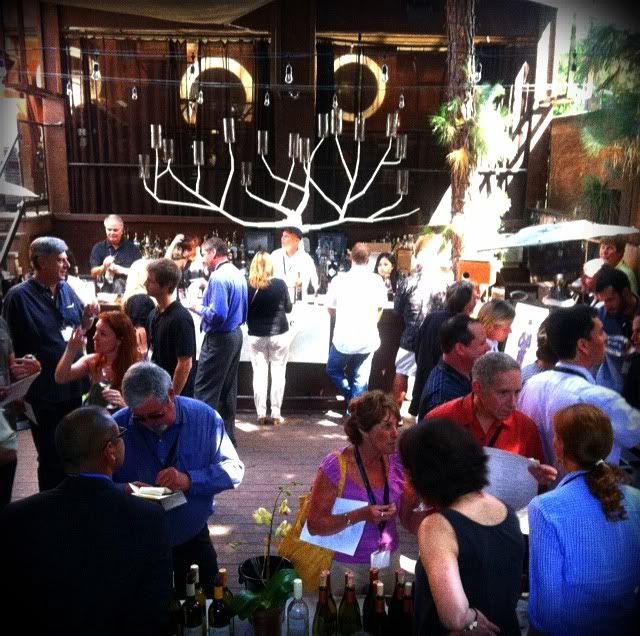
California has a bounty of culinary delights to offer. The STARS of California wine event, presented by Ian Blackburn’s Learn About Wine on Thursday June 23, 2011, showed off the wealth of California food and wine in a controlled environment - only 200 tickets were made available to the public event at the Broad Stage venue in Santa Monica, so a "no crowds" atmosphere was expected. I attended the trade session during the afternoon, which was held in the garden setting of Santa Monica's Wilshire Restaurant.
The Golden State also has a bounty of traffic snarls. I wonder how the road construction crews always seem to know where I'll be going, so they can block a lane or two on my route. The 10 mile trek from mid-Wilshire to the Wilshire Restaurant took an hour, and about the same for the return trip. It was Carmageddon! Even with the aggravation of traffic, the event made it worthwhile.
The wines were presented as "future stars" of the California wine scene - and many of the wineries in attendance do fly a little under the radar - but the "future star" status is definitely deserved for the likes of Flying Goat Cellars, Palmina, Presqu'ile and Inception Wines. There was plenty more to rave about, too.
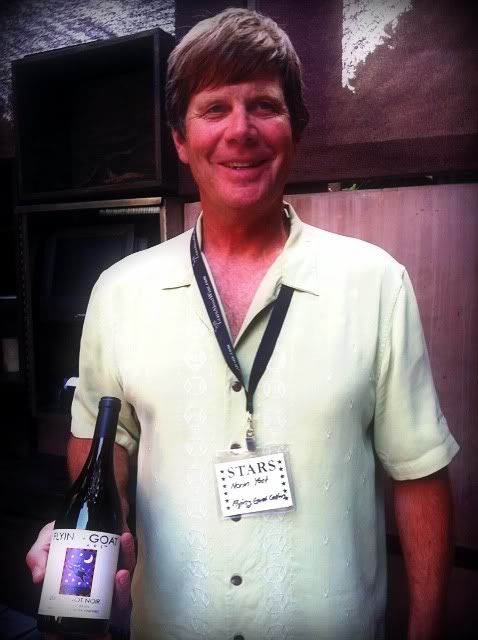 Norm Yost's Flying Goat Cellars of Santa Barbara always draws a crowd at Southern California tasting events. Norm (pictured at right) tasted me through a trio of his Pinot Noirs, each of which shows earthy minerality and wonderful acidity. My favorite is the 2008 Rancho Santa Rosa Pinot from the Santa Rita Hills. This 667 clone has a smokey nose and great black cherry flavor, with a mocha note that comes through into the finish.
Norm Yost's Flying Goat Cellars of Santa Barbara always draws a crowd at Southern California tasting events. Norm (pictured at right) tasted me through a trio of his Pinot Noirs, each of which shows earthy minerality and wonderful acidity. My favorite is the 2008 Rancho Santa Rosa Pinot from the Santa Rita Hills. This 667 clone has a smokey nose and great black cherry flavor, with a mocha note that comes through into the finish.
Randy Hazard of wine broker Vin 17 poured some delightful Pinot Noir and Chardonnay from Arroyo Grande's Center Of Effort. I was really taken with another wine he poured, the '09 Fossil Point Edna Valley Chardonnay. Nice tropical fruit and banana on the nose with great acidity and a zesty streak citrus on the palate bowled me over.
Palmina Wines features Italian varieties grown in Santa Barbara County. Honea Vineyard is the only vineyard in California planted exclusively to Italian grapes, and Steve Clifton buys their entire crop every year. I love the earthy minerality of their Arneis, the briny herbal palate of their Tocai Friulano and the wonderfully dry Rosato di Palmina. Palmina's '07 Nebbiolo of Santa Barbara County is a three-vineyard mix with earth, smoke and spices bursting forth.
Ryan Skinner, of Skinner Vineyards in the Sierra Foothills region, loves to pour his 2009Grenache, which winemaker Chris Pittenger produced like a Pinot. It's 100% Grenache, very dry, with a brilliant cherry nose and rich palate. I really liked their very dark and moody '07 Estate Syrah, too.
Santa Maria Valley winery Presqu'ile has been making some noise recently. Or, more accurately, those who try their wines have been making some noise; a lot of tweeting, especially. South African Winemaker Dieter Cronje has crafted some wonderful wines. Presqu'ile's 2009Chardonnay is clean and crisp. I'm told Cronje utilized 10% new oak in this wine out of necessity - just so he could have some neutral oak next year. The real stunner is the '09 Pinot Noirfashioned from a half-and-half mix of Solomon Hills and estate fruit. Delicious, flirty raspberry and a long finish.
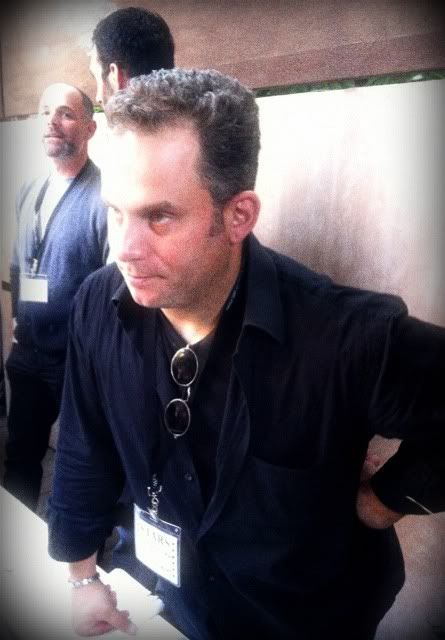 Based in Los Angeles, making Central Coast wines, is Inception. Owner George Pitsironis (left) says they are on the wine lists at a majority of fine dining places in Southern California. Their '09 Santa Barbara County Chardonnay is lush and creamy, but limited use of new French oak leaves the minerals in the front seat. Inception'sPinot Noirs had the best aromas I found at this event. A Central Coast effort and a Santa Barbara County Pinot both followed up with rich flavor. It was a soon-to-be-released '09 Santa Rita Hills Pinot from La Encantada Vineyard that really wowed. It should be available in mid-July 2011.
Based in Los Angeles, making Central Coast wines, is Inception. Owner George Pitsironis (left) says they are on the wine lists at a majority of fine dining places in Southern California. Their '09 Santa Barbara County Chardonnay is lush and creamy, but limited use of new French oak leaves the minerals in the front seat. Inception'sPinot Noirs had the best aromas I found at this event. A Central Coast effort and a Santa Barbara County Pinot both followed up with rich flavor. It was a soon-to-be-released '09 Santa Rita Hills Pinot from La Encantada Vineyard that really wowed. It should be available in mid-July 2011.
It was with great expectations that I stopped at the table of Lang and Reed, from the Napa Valley town of St. Helena. They do all Cabernet Franc, all the time. All their wines are based on Cab Franc, and John Skupny can do an impromptu dissertation on the grape and its clones anytime you like. With a shrug, he said "Somebody's gotta do it," when I admired his obsession. Lang and Reed's Two-Fourteen is made from the CF clone 214, which originated in the Loire Valley. It's a single-vineyard work with a beautiful vegetal edge and notes of coffee in its complex palate.
Arman Pahlavan's Starlite Vineyards poured an exceptional Viognier and Zinfandel. Winemaker Julia Iantosca - who took over from Merry Edwards in 2007 - worked wonders with the '09Viognier, a weighty, barrel-fermented white with great acidity and a floral honey nose that's irresistable. The '06 Zinfandel was crafted for the person "who doesn't like Zinfandel." I can't imagine who that could be, but this Alexander Valley beauty shows bright cherry, coffee, chocolate and spice, with plenty of acidity. It's made from a Primitivo clone. Starlite's Cabernet Sauvignon sports 15% Napa Valley Tempranillo and shows intense red fruit. I'm told many tasters mistake it for Bordeaux.
Mauritson Wines of Dry Creek Valley in Sonoma County scored with their Petite Sirah, indigo with concentrated fruit and great grip. I finished the session - appropriately enough - with Mauritson's Port-style dessert wine. Five Portuguese grape varieties are used for this blend. The sweetness bears an earthy counterpoint which makes me think it's not just for dessert.
Follow Randy Fuller on Twitter.
The wine industry in Nebraska began in the late 1800s, but never really got a major foothold. What was left of the Nebraska wine industry after Prohibition was decimated by a huge blizzard in 1940. There's an interesting story about that storm here.
Nebraska's first winery of the new era didn't open until 1994 and there are a couple dozen on the books now. There are no AVAs designated for Nebraska, but the University of Nebraska - Lincoln has a viticulture program.
Deb and Rick Barnett are the proprietors of Big Cottonwood Vineyards and Winery, a small farm winery located in the rolling hills of northeastern Nebraska four miles west of Tekamah and about 43 miles north of Omaha.
Big Cottonwood uses estate grown fruit as well as grapes from nearby Nebraska vineyards. They rely heavily upon grapes which are suited to cold weather - Frontenac, Seyval, Brianna, St. Vincent, De Chaunac, St. Croix, Vignoles and Prairie Star.
The Barnetts say Big Cottonwood is the only Nebraska winery they know of which makes a méthode champenoise sparkling wine. It's made from Brianna, a fairly new grape variety which can survive the brutal winters and is found mainly in Nebraska.
Their line known as The Pelicans are wines made as a tribute to Lewis and Clark's westward exploration over 200 years ago. There is a mural commemorating the trek on the side of the VFW hall in Tekamah. I like this facet of Nebraska wine, as the Wine Country series dabbles a bit in history, too. We are usually restricted more or less to the grape history of America.
The pelican tie-in results from the fact that the Lewis and Clark expedition stopped along the Missouri river east of Tekamah and shot a pelican there in order to measure it. That's how it was back in the pioneer days - shoot first and break out the tape measure later.
Big Cottonwood Winery was kind enough to supply two wines from their Pelican line as the Nebraska entry to Now And Zin's Wine Country series.
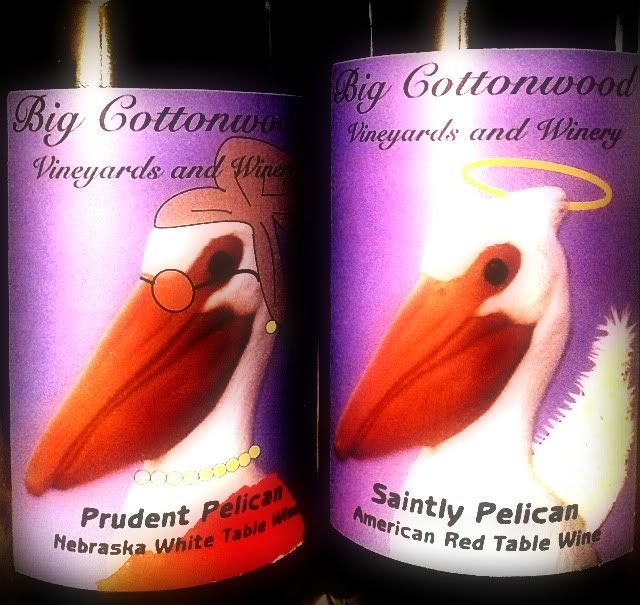 Prudent Pelican
Prudent Pelican
This white wine is a blend of Brianna and Prairie Star. Brianna is a hybrid grape developed by Wisconsin grape breeder Elmer Swenson, who also developed Prairie Star and St Croix.
It has a lovely golden color and the nose shows a honeyed herbaceousness. The wine is off dry with a medium mouthfeel. Flavors of dried pineapple and banana - are carried along on a vibrant acidity. I’d love some shrimp or a swordfish steak with this.
Saintly Pelican
This red table wine is a blend of St. Vincent and St. Croix - another pair of hybrid grapes - hence the "sainted" name.
Medium ruby in the glass, it's not so dark that I can’t see through it. The nose has a rubber aroma and a strong scent of mint. An unusual spice aroma wafts in and out, and there’s a note of brown sugar. To say the least, it's quite a striking and distinct aroma package.
On the palate, it’s just as distinctive. Very dry and rough hewn, the tannins are not too tough to handle, but they do speak up. Flavors of sour cherry draped in tart raspberry make me want to pair it with grilled chicken or venison sausage. A ferric quality persists into the finish, which is lengthy.
Both of these Nebraska wines from Big Cottonwood are very different tastes for a palate accustomed to wine made from vinifera grapes. This is part of the American wine experience, though. I’m glad I had the chance to get to know these grapes a bit. I hope you'll get that chance, too.
Follow Randy Fuller on Twitter.

Wine Goes To The Movies
with NowAndZin.com and TrailersFromHell.com
"Rosemary’s Baby" gives us a glimpse of just how far an actor will go to get a role. Make a deal with the devil? Okay. Pimp out your wife to Satan? Hey, residuals are residuals. The conflict between God and the devil really boils down to artistic differences. They're both directors, and they each want a different ending. Considering all the devil-worshiping in "Rosemary's Baby," some may want to watch it while drinking sacramental wine - naked.
John Cassavetes as struggling actor Guy Woodhouse displays a lack of moral character usually reserved for agents, or so they say. Mia Farrow as his wife, Rosemary, shows once and for all that it's not paranoia if they really are out to... well, you know, screw you.
There's a lot of drinking in the movie, so you should feel right at home uncorking a bottle and having a hell of a good time. Raise a special toast when Hutch says, "Have some more wine," this movie's "Hi, Bob" moment.
The Swingin' Sixties tone of "Rosemary's Baby" is set with Mia Farrow's groovy fashions and Vidal Sassoon haircut, and it gets kicked up a notch when Roman Castevet brings out that tray of Vodka Blush cocktails.
It can be argued that no woman in movie history ever needed - or deserved - a drink more than Rosemary. After all, the devil got to know her - in the biblical sense. She needed a real drink, not that homebrew made from tannis root that Minnie Castevet kept pushing on her. Tannis root, by the way, is not to be confused with the tana leaves that brought The Mummy back to life.
On to the pairing. Napa Valley's Stone's Throw Winery has a Cabernet Sauvignon called Rosemary's Baby, but it doesn't even have any devil imagery on the label. There's a Rosemary's Baby India Pale Ale, but I don't see a craft beer working, either. There’s no sin in having a beverage with a head - but what’s wrong with its eyes!!
As long as we're dealing with the devil's apartment, how about going downstairs to the devil's cellar? The Chilean winery Concho Y Toro makes a wine by that very name, albeit in Spanish. Casillero del Diablo celebrates the legend of the winery's founder. They say he discovered some of his primo wine missing from the cellar, so he put out the word that the devil lived there. That kept everybody away, except the ambitious actor who sublet it.
7 Deadly Zins, though, is my choice of wine to pair with "Rosemary's Baby," for obvious reasons. It's actually named for the seven Lodi vineyards from which the grapes were harvested, not the seven deadly sins which can probably be repeated - chapter and verse - by anyone with a Catholic school background.
Before we close the page to resume our sinnin' and movie watchin', let's have a little fun. I have one more wine to suggest for "Rosemary's Baby" - Tell Tom Evil Revved.
"The name’s an anagram."
If you're stumped, or just hate puzzles, come back next Thursday for the answer in Blood Of The Vines.
Follow Randy Fuller on Twitter.
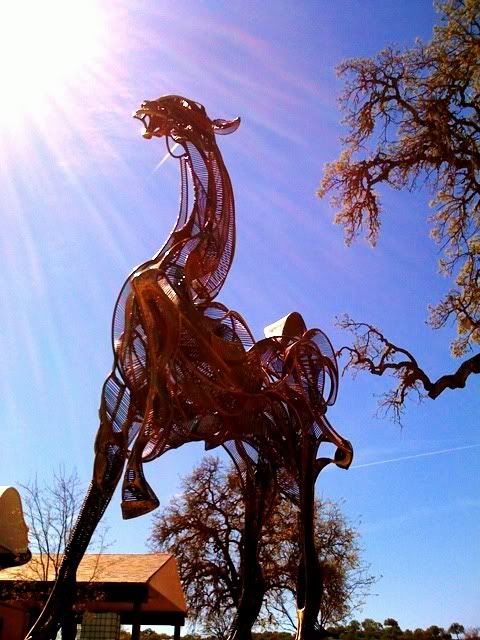
There is a long list of winery tasting rooms in Paso Robles which are fun to visit, but there's one you really have to see. Sculpterra Winery pours some good wine, but they also show off some dandy visual arts to go with it.
Sculpterra's property is adorned with beautiful iron work from master blacksmith Bob Bentley and the tasting room features contemporary art by Aleah Koury. The grounds around the tasting room are a real treat, with sculptures in bronze and granite by John Jagger.
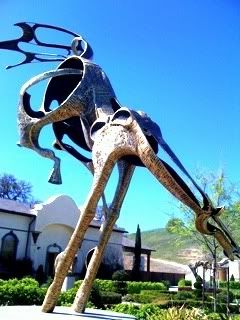 Pictures don't really do justice, so plan a visit to Sculpterra for your next trip to Paso Robles. You'll be glad you did. Just don't get so mesmerized outside that you forget to go inside to taste the wine.
Pictures don't really do justice, so plan a visit to Sculpterra for your next trip to Paso Robles. You'll be glad you did. Just don't get so mesmerized outside that you forget to go inside to taste the wine.
The Frankel family started out growing pistachios and a few grapes. The grapes won, as they now dominate their 260 acre estate vineyard. They're still nuts about their pistachios, though. Have some from the tasting bar.
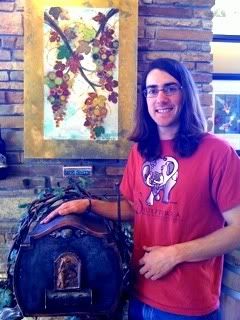 Young winemaker Paul Frankel is a 2009 grad of Cal Poly SLO. He has already shown his stuff in the winemaking game, sculpting some very nice wines to rival the sculptures outside the doors.
Young winemaker Paul Frankel is a 2009 grad of Cal Poly SLO. He has already shown his stuff in the winemaking game, sculpting some very nice wines to rival the sculptures outside the doors.
Sculpterra's 2010 Chardonnay is a steely white, while the 2009 Viognier has a big, floral nose with flavors of pears and honey.
The 2007 Merlot shows beautiful, smokey, red fruit, while their '07 Zinfandel is actually Primitivo. Great spices abound in the '07 Syrah from O'Neal Vineyard.
 The Sculpterra Cabs are wonderful. The '07 has a zin-like nose and evidence of the American and Hungarian oak. The '05 Cabernet Sauvigon - a library wine - is silky smooth with gentle tannins and a pencil point edge. The '06 Cab is much fruitier than the '05, and gives some nice minty, herbal notes.
The Sculpterra Cabs are wonderful. The '07 has a zin-like nose and evidence of the American and Hungarian oak. The '05 Cabernet Sauvigon - a library wine - is silky smooth with gentle tannins and a pencil point edge. The '06 Cab is much fruitier than the '05, and gives some nice minty, herbal notes.
The 2007 Figurine is Paul's initial stab at winemaking, and he really nailed it. Equal parts Cab and Zin with a bit of Merlot, this wine lets the different varieties really shine. The '07 Maquette shows a lot of graphite. It's 63% Cabernet Sauvignon, 25% Merlot and 12% Petite Sirah.
They also poured the dense '08 Petite Sirah and a non-vintage Zinfandel dessert wine. The late-harvest Zin is a Port-style wine with brilliant flavors that cry out for some blue cheese.
Follow Randy Fuller on Twitter.
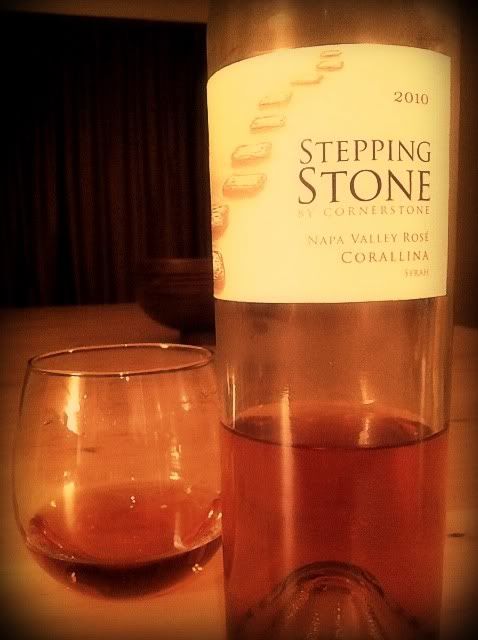
We have tasted and written about the Stepping Stone Riesling and Sauvignon Blanc Cuvée Musqué from Napa Valley's Cornerstone Cellars. Both are great wines for warm weather sipping. The winery also provided their rosé for our perusal.
Winemaker Jeff Keene did a fine job on the two under-$20-whites we tried, and his efforts with the pink produced similar results.
The Stepping Stone Corallina Rosé is made of Napa Valley Syrah, carries a very moderate 13.9% abv number and retails for $18. Cornerstone says the name "Corallina" is Italian for "coral," which is a pretty fair description of the color of this wine.
A beautiful nose of strawberry fruit and Pez candy sails along on an herbal undercurrent. There's no cloying sweetness here, not even close. It's bone dry with a zing of acidity right off the bat. The slightest trace of white pepper gives way to a beautiful layer of cherry and strawberry flavors overlayed with minerals. This wine will be welcome on the deck all summer, and on the lunch table any time of year.
Follow Randy Fuller on Twitter.

Wine aficionados always want to be on the leading edge of wine trends. At the London International Wine Fair, held in May, wine experts identified and explored trends in the wine world they felt were worthy of inspection.
An article in The Independent cites a trend toward wines with citrus - specifically lime - aromatics as one of the next big things these wine experts were expecting. Surprising blends and a deep and abiding love of Pinot Grigio were also singled out as major directions in the wine world.
A spokesperson for the event said the Austrian Rotgipfler is one grape those in the know are keeping in their sights, as well as the South African wine called Zevenwacht. That's a blend of Sauvignon Blanc, Viognier and Chardonnay.
The lime and citrus notes of Riesling and Gewurztraminer are said to be winning over wine drinkers everywhere, as is the Italian bubbly Prosecco. According to the spokesperson, many people find Prosecco's lighter approach preferable to the drier, heavier feel of Champagne.
The event spokesperson claimed that people seem to be "moving away from pure fruit... towards more restrained, elegant characteristics."
Follow Randy Fuller on Twitter.

One of Temecula’s showcase wineries - South Coast Winery - held their second live-streamed Group Therapy session of 2011 on May 25th. Interested parties watched the live video stream and tweeted with one another - and the world - about the wines they were tasting.
The event is designed to coincide with their wine club shipments, so you can expect another Group Therapy session sometime in August. Tasters were able to order ahead of time the package of wines being featured so they could taste and tweet along with everyone else. Now And Zin was provided with complimentary samples for review.
With one event like this already under their belts, the group at South Coast Winery seemed pretty relaxed in their comfy chairs in front of a cozy fireplace. South Coast Owner Jim Carter and winemakers Jon McPherson and Javier Flores held the fireside chat in a living room setting with the logs burning behind them. Carter used the homey setting to announce that the South Coast wines will soon be distributed nationally.
The participants on the viewing end had a nice time, too. In addition to those tasting in person, there were wine lovers chatting on the winery’s website and on Twitter about the four wines in the tasting group. I caught several comments indicating pleasant surprise at the quality of the wines as well as at least one complaining of overly ripe fruit. That’s a matter for debate; while the flavors were admittedly big, I didn’t feel it was something unexpected from grapes grown in Southern California.
Here are the wines which were tasted in the most recent Group Therapy session:
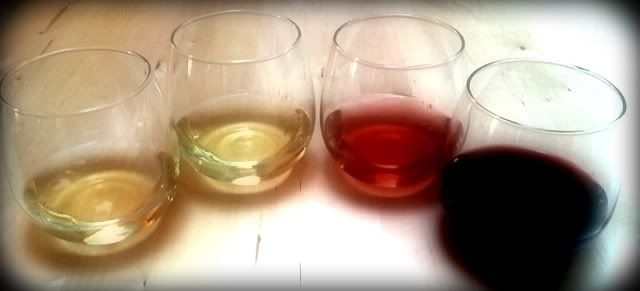 South Coast Winery Sauvignon Blanc Musqué Clone 2009
South Coast Winery Sauvignon Blanc Musqué Clone 2009
Temecula Valley Carter Estate Vineyard
This extremely aromatic wine is made entirely of the Musqué clone of Sauvignon Blanc. That’s a cross between Sauvignon Blanc and Muscat. This clone allows the florality of Muscat to soften the acute grassiness of Sauvignon Blanc. The Carter Estate Vineyard, from which the grapes come, is now seven years old. The wine has an amazingly low alcohol level of 12.2% abv.
Light in color and beautifully aromatic, the wine has generous notes of fresh cut grass and a driveway after a brief rain. The mouthfeel comes on strong, too. There’s a striking acidity, with flavors of lemon peel and minerals.
South Coast Winery Brut 2007
Temecula Valley Sparkling Wine
70% Chardonnay and 30% Pinot Noir, this sparkler shows off its main grape. Most of the fermentation was in stainless steel, while only 12% of the blend was fermented in new French oak. Closed cuve secondary fermentation with 11 months on the lees finished this methode champenoise offering. The alcohol level is 13% abv.
Despite the limited exposure to oak, there's a very aromatic nose with huge yeasty notes. Flavors of apples and citrus dominate the palate, and there is quite a bit of acidity. It's a very fizzy wine, but when the bubbles die down it takes on the feel of a dry still wine with a touch of yeastiness. Several tasters were pining for some sushi to pair with it.
South Coast Winery Tempranillo Rosé 2010
Temecula Valley Carter Estate Vineyard
This Temecula Tempranillo is a beautiful light magenta color. The nose is, once again, aromatic. Strawberries are met with a touch of funk, while herbal berry aromas also come into play. The wine offers a zippy acidity, and the strawberry and cherry flavors are enormous!
South Coast Winery Syrah 2005
Temecula Valley Rolling Hills Estate Vineyard
This Syrah was fermented in stainless steel and aged 14 months in French/American hybrid barrels. The 14.3% abv alcohol level makes itself known on the nose, which is all spices, vanilla and clove layering over the blackberry and cassis fruit. Definitely not a cool climate Syrah, there's a ton of very ripe and juicy aromas with lots of spice and a touch of tar.
The palate shows intense fruit with big spice flavors as well. There's a lot of influence from the oak at first and it runs a bit hot, so let it sit a while or decant before serving. The wine shows a great meatiness after it opens up a bit. Three days after opening the nose is incredible. Tar, leather, meat and sage all play with an admirable complexity.
Follow Randy Fuller on Twitter.

The heat’s killing me. Just the short walk down to that crummy wine bar in Hollywood has soaked my shirt through. It's not a good look for a pool boy, much less a hard-boiled insurance man. Sometimes it's hard to to tell us apart.
I remember when I could walk down the street and get liquor. I could get liquored up, if I wanted. Now, wine bars all over Hollywood. Even in Los Feliz. One good thing about wine bars: you'll always find plenty of slick dames hanging around in them. None like her, though. None like Phyllis Dietrichson. Nobody can touch her, or that honey of an anklet she wore. Well, almost nobody.
Something was hinky about that Los Feliz iced tea she gave me. I asked if she had a bottle of beer that wasn't working, but I guess they were all busy. At my place, I thought she should have had some of that pink wine. The kind that bubbles. All I had was bourbon. Bourbon was enough for Phyllis.
The room started spinning and I dreamed I slipped out of character and headed up to MacMurray Ranch. It's in the Russian River Valley, prettiest place you ever saw. I bought it in '41, as a getaway from troubles just like this. After I'm done here, they'll probably sell the cattle and plant grapes. Maybe avocados. No, grapes. The better for making wine. Wine, to sell in wine bars to an everyman like me, Walter Neff. Wine, to be lifted as a toast to a slick dame like Phyllis. A slick dame like Phyllis who can have her way with a guy like Walter Neff.
How could I have known what kind of poison she was? How could I have known that anklet she wore was like a sign saying "Bad dog - keep away?" How could I have known wine bars would ever become so popular? How could I have known something so sweet, rich and powerful could go so bad?
How could I have known that murder can sometimes smell like honeysuckle?
Blood Of The Vines suggests pairing "Double Indemnity" with the 2009 MacMurray Ranch Pinot Noir, Russian River Valley. It features earthy cherry flavors - rich, sweet and powerful. It retails for $35.
Follow Randy Fuller on Twitter.



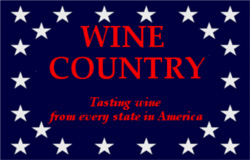
 Canyon Wind Wines
Canyon Wind Wines




 The tables offering wine were typically crowded, as were the sites where a morsel of food could be sampled. I stopped and chatted with a fellow named Mark, who manned the
The tables offering wine were typically crowded, as were the sites where a morsel of food could be sampled. I stopped and chatted with a fellow named Mark, who manned the  Rob Barnett, CEO and founder of
Rob Barnett, CEO and founder of  Mendocino County's
Mendocino County's  Bixler Vineyards
Bixler Vineyards


 Greco di Tufo, Terradora DiPaolo, Campania 2010 -
Greco di Tufo, Terradora DiPaolo, Campania 2010 - Just up the street is
Just up the street is 
 Norm Yost's
Norm Yost's  Based in Los Angeles, making Central Coast wines, is
Based in Los Angeles, making Central Coast wines, is  Prudent Pelican
Prudent Pelican

 Pictures don't really do justice, so plan a visit to Sculpterra for your next trip to Paso Robles. You'll be glad you did. Just don't get so mesmerized outside that you forget to go inside to taste the wine.
Pictures don't really do justice, so plan a visit to Sculpterra for your next trip to Paso Robles. You'll be glad you did. Just don't get so mesmerized outside that you forget to go inside to taste the wine. Young winemaker Paul Frankel is a 2009 grad of Cal Poly SLO. He has already shown his stuff in the winemaking game, sculpting some very nice wines to rival the sculptures outside the doors.
Young winemaker Paul Frankel is a 2009 grad of Cal Poly SLO. He has already shown his stuff in the winemaking game, sculpting some very nice wines to rival the sculptures outside the doors. The Sculpterra Cabs are wonderful. The '07 has a zin-like nose and evidence of the American and Hungarian oak. The '05 Cabernet Sauvigon - a library wine - is silky smooth with gentle tannins and a pencil point edge. The '06 Cab is much fruitier than the '05, and gives some nice minty, herbal notes.
The Sculpterra Cabs are wonderful. The '07 has a zin-like nose and evidence of the American and Hungarian oak. The '05 Cabernet Sauvigon - a library wine - is silky smooth with gentle tannins and a pencil point edge. The '06 Cab is much fruitier than the '05, and gives some nice minty, herbal notes.


 South Coast Winery Sauvignon Blanc Musqué Clone 2009
South Coast Winery Sauvignon Blanc Musqué Clone 2009 